Click image for BBB rating
See our Privacy Policy
cool="cool" width="786" height="8641" border="0" cellpadding="0" cellspacing="0" gridx="16" showgridx="showgridx" usegridx="usegridx" gridy="16" showgridy="showgridy" usegridy="usegridy" bgcolor="#99ccff">
|
|
|
|
|
|
|
|
Spaightwood Galleries
|
|
|
|
|
|
If there is a twentieth-century artist who truly needs no introduction, it is Picasso; if there is a twentieth-century artist about whom more books have been written than Picasso, we have no idea who it might be. In any case, Picasso is not going to get much of a general introduction here. Rather, a general introduction to the works in our inventory must suffice. Picasso was a wildly inventive artist who periodically returned from whatever voyage he was undertaking to rest, refresh himself with the familiar—classically-drawn people, bullfights, dances, animals, birds, insects, flowers, the artist and his model, love and lust—before venturing out for further explorations,. Picasso helped invent the artistic vocabulary of Cubism, Surrealism, and Post-Modernism. Along with a few other artists—Matisse, Kandinsky, Braque, Miró, Chagall, Léger, Giacometti, and Magritte spring quickly to mind—he invented modernity in art for the twentieth century. On this page and several linked pages, we present a sampling of the themes of our 2007-2008 Winter show: Masters of Modernity.
Bibliography: The literature on Picasso is enormous. We list here only catalogue raisonnés for his prints: Georges Bloch, Volume I: Catalogue of the Printed Graphic Work 1904-1967 (Berne: Editions Kornfeld and Klipstein, 1971); Georges Bloch, Volume II: Catalogue of the Printed Graphic Work 1966-1969 (Berne: Editions Kornfeld and Klipstein, 1971); Galerie Louis Leiris, Picasso: 156 Gravure Récentes (Paris: Galerie Louis Leiris, 1973); Sebastian Goeppert, Herma Goeppert-Frank, & Patrick Cramer, Pablo Picasso The Illustrated Books: Catalogue Raisonné (Geneva: Patrick Cramer, 1983); Ulrike Gauss, Pablo Picasso Lithographs (NY: D. A. P., 2000); Fernand Mourlot, Picasso Lithographs (Boston: Boston Book and Art, 1970). The Gauss Lithographs uses the same numbers as the Mourlot catalogue, but illustrates color prints in color; the 156 Gravures picture book was published by Picasso's longtime gallery and illustrates the entire series, otherwise not to be found except in the very rare Bloch Volume IV. Cramer illustrates all of Picasso's prints for books and art reviews and provides an authoritative source for information about the sizes of editions and the various papers used for the prints.
|
|
|
|
|
|
|
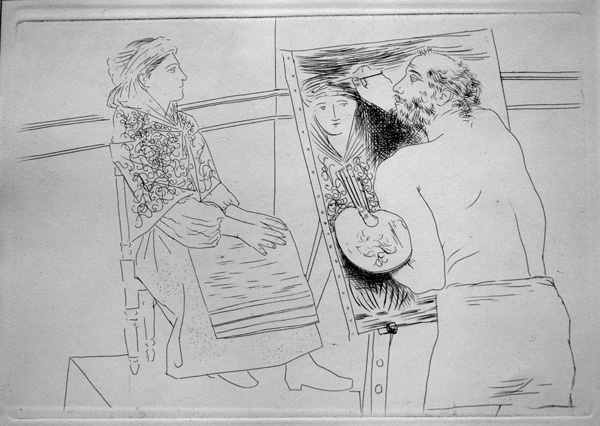 |
|
|
Pablo Picasso (Spanish, 1881-1973), Peintre chauve devant son Chevalet / Bald painter at this easel (B. 87; G. 128/b). Original etching, 1927. 65 signed impressions on Japan plus 340 unsigned impressions (of which 240 are printed on Rives as ours). This etching, commissioned and published by Ambroise Vollard and printed by Louis Fort, was published in 1931 for his deluxe artist's book of Balzac's Le Chef-d'Oeuvre inconnu / The unknown artist's masterpiece. Each pencil-signed portfolio contained 13 unsigned etchings and 67 wood-engravings by Georges Aubert after Picasso's drawings. Illustrated in Picasso: 60 Years of Graphic Works (LA County Museum of Art, 1967, p. 37) and Magdalena M. Moeller, Picasso Druckgraphik . . . aus dem Sprengel Museum Hannover (Propylaen, 1986, p. 82). Image size: 194x278mm. Price: Please call or email for current pricing information.
|
|
|
|
|
|
|
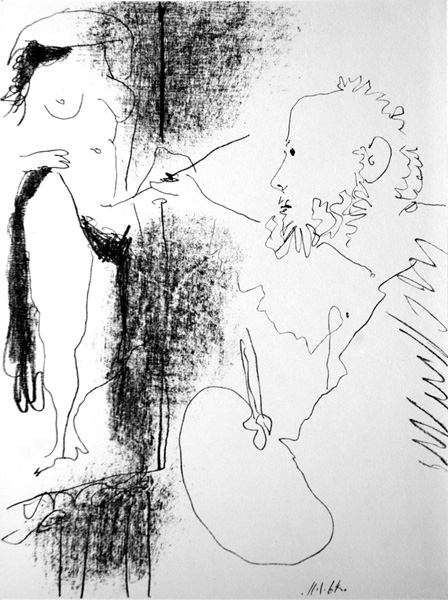 |
|
Pablo Picasso (Spanish, 1881-1973), The Painter and his Model (Mourlot 399, Bloch 1155). Original lithograph, 1964. 3000 unsigned impressions for Picasso Lithographe IV. This lithograph served as the frontispiece to the book. It is one of a long series of lithographs and etchings Picasso has made on this theme, which was particularly important to him from 1963-65. Image size: 320x235mm. Price: Please call or email for current pricing information. Mourlot 399 and Mourlot 400 were executed on the same day.
|
|
|
|
|
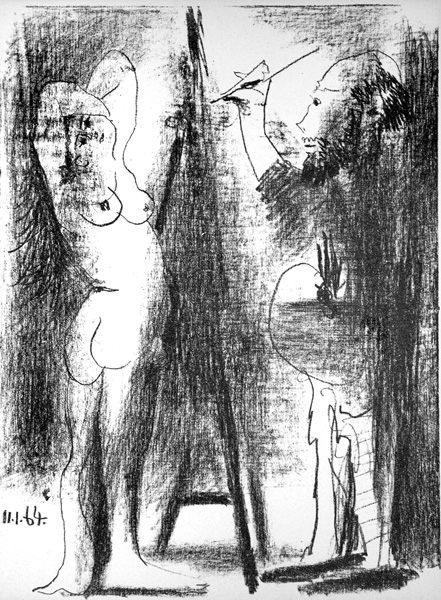 |
|
|
Pablo Picasso (Spanish, 1881-1973), The Painter and his Model II (Mourlot 400, Bloch 1142). Original lithograph, 1964. 2000 unsigned impressions for the Smithsonian's Mourlot catalog + 1150 impressions for L'Atelier de Mourlot at Redfern Gallery. It is one of a long series of lithographs and etchings Picasso has made on this theme, which was particularly important to him from 1963-65. Image size: 250x180mm. Price: Please call or email for current pricing information. Mourlot 399 and Mourlot 400 were executed on the same day.
|
|
|
|
|
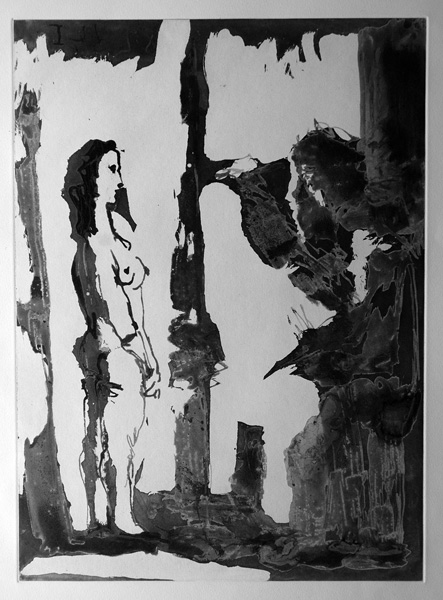 |
|
Pablo Picasso (Spanish, 1881-1973), Peintre et Modele aux Chevaux longs / Painter and Model with long hair (Bloch 1184). Original aquatint, 1965. 80 signed & numbered impressions on various papers + 255 unsigned impressions for the deluxe portfolio, Sable Mouvant (1966), of which our impression is one. Another from the wonderful series of prints on the theme of the artist and his model that Picasso worked on during 1963-65. Printed at Aldo Crommelynck's atelier. The work has been illustrated in several books on Picasso, including Magdalena M. Moeller, Picasso: Druckgraphik, illustrierte Bucher, Zeichnungen, Collagen und Gemalde / Prints, Illustrated Books, Drawings, Collages, and Paintings (Hannover: Sprengel Museum, 1986), p. 321, and Sebastian Goeppert, Herma Goeppert-Frank, and Patrick Cramer, Pablo Picasso The Illustrated Books: Catalogue Raisonne (Geneva: Patrick Cramer, 1983). Image size: 387x280mm. Price: Please call or email for current pricing information.
|
|
|
|
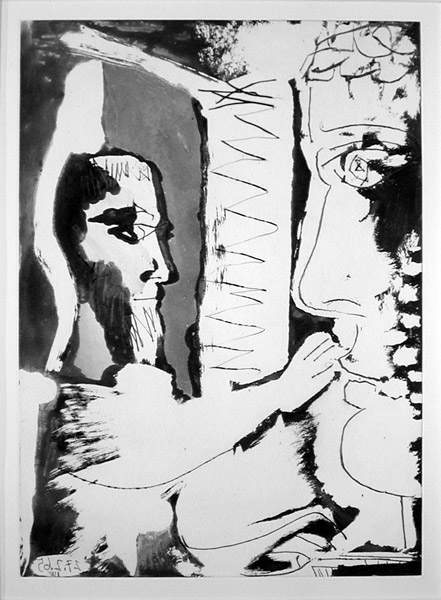 |
|
Pablo Picasso (Spanish, 1881-1973), Sculpteur et Sculpture (Bloch 1187). Original aquatint, 1965. 80 signed & numbered impressions on various papers + 255 unsigned impressions for the deluxe portfolio, Sable Mouvant (1966), of which our impression is one. One of the most beautiful of the series of prints on the theme of the artist and his model that Picasso worked on during 1963-65. Printed at Aldo Crommelynck's atelier. The work has been illustrated in several books on Picasso, including Magdalena M. Moeller, Picasso: Druckgraphik, illustrierte Bucher, Zeichnungen, Collagen und Gemalde / Prints, Illustrated Books, Drawings, Collages, and Paintings (Hannover: Sprengel Museum, 1986), p. 321, and Sebastian Goeppert, Herma Goeppert-Frank, and Patrick Cramer, Pablo Picasso The Illustrated Books: Catalogue Raisonne (Geneva: Patrick Cramer, 1983). Image size: 387x280mm. Price: Please call or email for current pricing information.
|
|
|
|
|
|
|
|
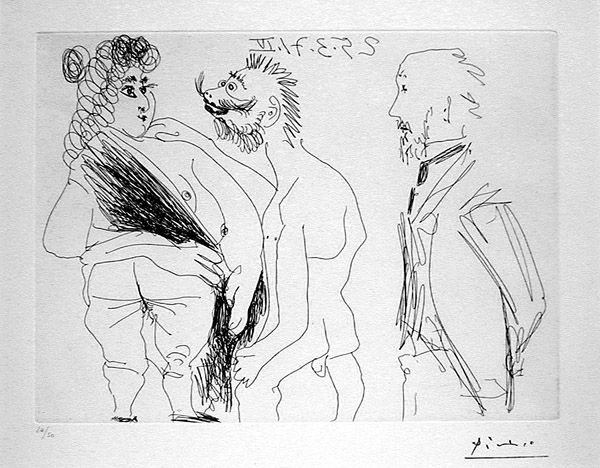 |
|
|
Pablo Picasso (Spanish, 1881-1973), Degas in the Bordello (Series 156 n. 95). Original etching, 1971 50 numbered impressions signed with the estate signature stamp. Executed 3/25/71 and approved by Picasso before his death, this etching, like the others in this series, was printed posthumously. Image size: 230x310mm. Price: Please call or email for current pricing information.
|
|
|
|
|
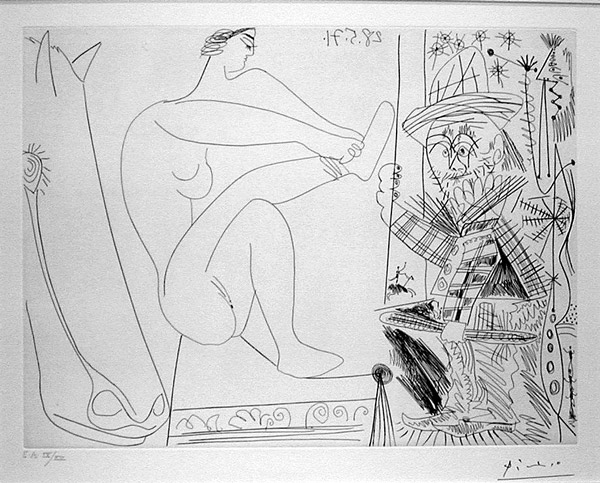 |
|
|
Pablo Picasso (Spanish, 1881-1973), Series 156: 135: Artist and Model (B. 1990; Series 156 n. 135). Original etching, 1971. 50 numbered impressions signed with the estate signature stamp. Executed 3/28/71 and approved by Picasso before his death, this etching, like the others in this series, was printed posthumously. Ours is an artist's proof, inscribed "E. A. IX/XVI." An old artist watches a beautiful young model. One of the largest in the 156 Series, most of which show aging artists (including Rembrandt, Degas, and Picasso himself) looking at their beautiful young models. Image size: 320x420mm. Price: Please call or email for current pricing information.
|
|
|
|
|
|
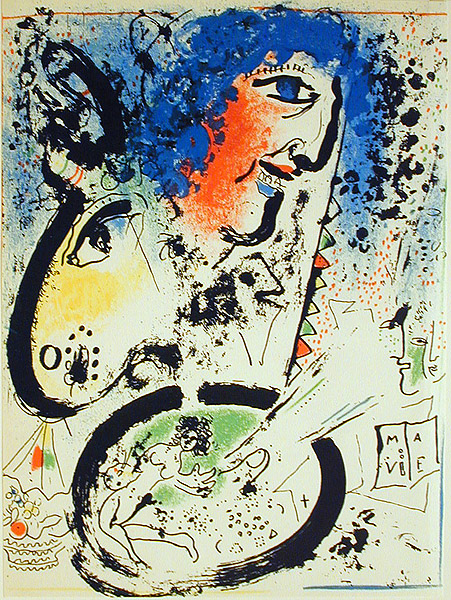 |
|
Marc Chagall (Russia 1887-1985 Paris), Self Portrait: Ma Vie (M. 282). Original color lithograph, 1960. 100 numbered impressions + c. 2000 unsigned impressions for Chagall Lithographe I. There were also 40 signed and numbered impressions reserved for the artist. Illustrated in the 1988 Moscow Chagall Exhibition. In this lithograph, Chagall presents himslef as the ringmaster of the circus of his own life, the main ring of the circus as a kind of palette with which he can create himslef everyday in his work. Image size: 325x250mm. Price: Please call or email for current pricing information.
|
|
|
|
|
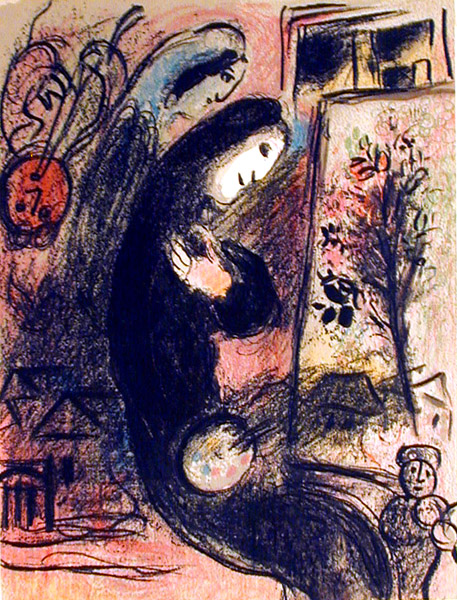 |
|
Marc Chagall (Russia 1887-1985 Paris), The artist inspired (M. 398). Original color lithograph, 1963. 40 signed & numbered + c. 2000 unsigned impressions for Chagall Lithographe Volume II. Illustrated in the 1988 Moscow Chagall Exhibition. Image size: 320x240mm. Price: Please call or email for current pricing information.
|
|
|
|
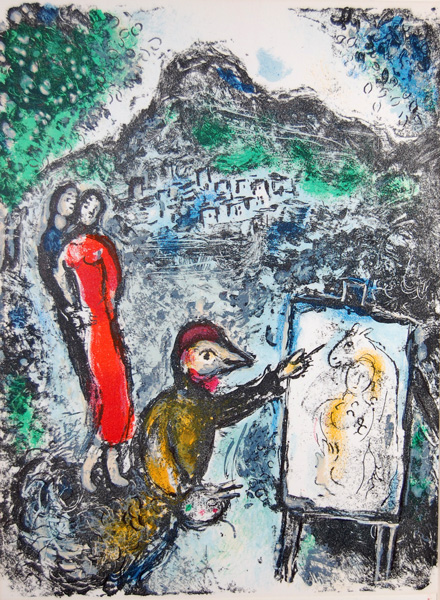 |
|
Marc Chagall (Russia 1887-1985 Paris), Devant Saint-Jeannet (M. 646). Original color lithograph, 1972. 50 signed & numbered impressions + 10 000 unsigned impressions for Ceramiques et Sculptures de Chagall. One of the most beautiful of Chagall's later lithographs, it features a rooster-headed artist painting a portrait of a pair of lovers, with the man portrayed with the horse's head (or perhaps the ass's head from A Midsummer Night's Dream? see Charles Sorlier, Chagall Ceramic Sculpture, p. 188 for Bottom and Titania) so often featured in Chagall's works. Image size: 310x235mm. Price: Please call or email for current pricing information.
|
|
|
|
|
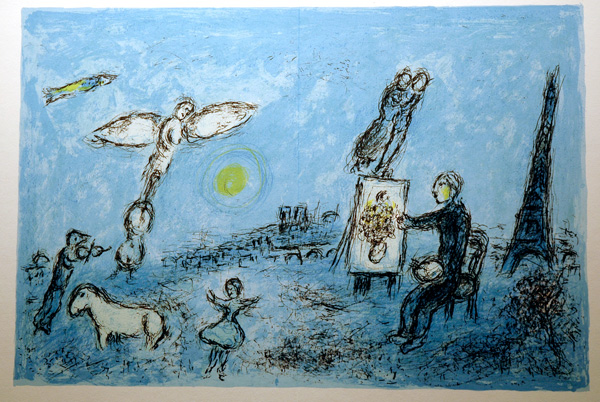 |
|
|
Marc Chagall (Russia 1887-1985 Paris), The painter and his double (M. 992). Original color lithograph, 1981. 15,000 unsigned impressions. This lithograph is partially reproduced on the cover of Chagall Lithographe V. Ours is an unsigned impression as taken from the deluxe art review, Derrière le Miroir. One of Chagall's most beautiful and important late lithographs. Image size: 300x410mm. Price: Please call or email for current pricing information.
|
|
|
|
|
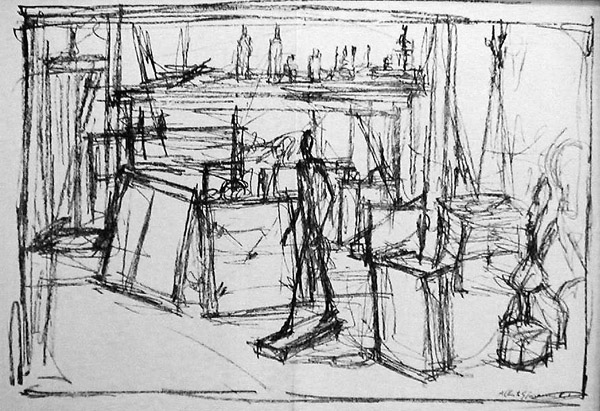 |
|
|
Alberto Giacometti (Swiss, 1901-1966), "Man Walking" in the Studio (Lust 94). Original lithograph, 1951. Published in the deluxe art review, Derrière le Miroir. Edition unknown (c. 1000 impressions signed in the stone; there are no pencil-signed impressions.) With the usual centerfold. The browning is only in the photograph; all images are on uniformly white paper. Image size: 380x560mm. Price: Please call or email for current pricing information.
Herbert Lust's catalogue of Giacometti's original prints lists 353 items, more than half of which were done for books and special issues of deluxe art reviews; several more have been added to a recent reissue of that catalogue. A new catalogue raisonné is about to appear to accompany a complete retrospective of Giacometti's prints at the Bibliotheque Nationale in Paris (November 2007). There is a general consensus that three of his very greatest lithographs were published in the 1951 issue of the deluxe art review Derriere le Miroir dedicated to his work. Lust describes his reaction to seeing these works in Giacometti's studio:
Entering Giacometti's studio [in the spring of 1951], which was filled with his finest sculptures, I found the artist peering at some sheets crammed with violent black slashes. The sheet in his hand made me catch my breath. It was a lithograph of the studio [Lust 94] with the statue of the Man Walking cutting across the center. It hit me like a bomb, like a wild primeval explosion in the earth. It was one of the most dramatic works I had ever seen in black and white.
The lithograph turned out to be the centerpiece for the catalogue of the Maeght show, the finest Alberto was ever to have, and one that embraced almost all of his great statues. . . . The catalogue for the show was a text by that austere poet Michel Leiris . . . illustrated by three lithographs [Lust 92-94] by Alberto. Thus, it was at the very height of his creative surge, with all his abilities straining at full stream, with his talents turning more and more toward painting, that Giacometti did his first great lithographs, those at which he was peering that spring day.
Little wonder that, given the fevered circumstances and the ideal situation, Alberto never surpassed these particular lithographs, though in 1954 he equaled them. These first drawings on stone represent the collision of his mature sculptural style with his newly discovered mastery of painting. These four lithographs [including the poster for the show] concern the studio and portray: a group of standing statues and busts with the catalogue's title printed at the top and bottom (93); his wife, sculptures of a horse and other subjects (92); a panoramic view of the studio with the Man Walking in the center (94). (Lust 73-74)
Lust prized these lithographs because he loved Giacometti's sculptures, which even them were beyond the reach of all but the wealthy. As he says to the artist, "Everything you have ever done as an artist is in them. One gets the same feeling from these lithographs as from the actual bronzes" (p. 74). Lust goes on to suggest that "Giacometti looked upon his bronzes as suprahumans. And since in 1951 and 1954 he became an audience to his studio, stood in wonder before his bronzes, at times perhaps not believing he had created them, he became, as he recorded them for history, rather like the chorus in a Greek play in which his statues were the players. For Lust, the wonder of Giacometti's studio lithographs is that "never has a cycle of prints by a major artist been so austere and stark, so devoid of charm and seductions. Giacometti had focused all his efforts on the severe stark architecture of his heart." In these works, Lust concludes, he gives us "the black ecstasy of an imagination that is its own prison" (75).
Chiara Negri, "Giacometti Lithographer and Etcher," singles out the three lithographs for the 1951 Derriere le Miroir and three of the 1954 Studio lithographs (including Annette in the Studio [Lust 10]) as the best examples of his lithographs, "the very keystone of Giacometti's entire output" (2): "All show the studio, cluttered with sculptures, paintings, stools, trestles, chairs and all the tools and tackle of a sculptor. All three [of the 1951 Derriere le Miroir lithographs] include a figure (either a person . . . of a sculpture in the center of the sheet, the pivot of the whole composition. The significance of "Annette" goes beyond the figures merely formal function (as a balancing element for the whole scene). She . . . is above all else a symbol of the relationship between the artist and his art, i.e. his own works. Giacometti went on to produce an enormous number of other lithographs, possibly technically more successful, but never showing with more clarity the value of graphics as a means of reflection on his own activity, and therefore on his own existence" (11).
|
|
|
|
|
|
Spaightwood Galleries, Inc.
To purchase, call us at 1-800-809-3343 (1-508-529-2511 in Upton MA & vicinity) or send an email to spaightwood@gmail.com. We accept AmericanExpress, DiscoverCard, MasterCard, and Visa.
For directions and visiting information, please call. We are, of course, always available over the web and by telephone (see above for contact information). Click the following for links to past shows and artists. For a visual tour of the gallery, please click here. For information about Andy Weiner and Sonja Hansard-Weiner, please click here. For a list of special offers currently available, see Specials.
Visiting hours: Saturday 10:00 am to 5:00 pm and Sunday noon to 6:00 pm and other times by arrangement. Please call to confirm your visit. Browsers and guests are welcome.
|
|
|
|
|
|
|
|
|
|
|
|
|
|
|
|
|
|
|
|
|
|
|
|
|
|
|
|
|
|
|
|
|
|
|
|











